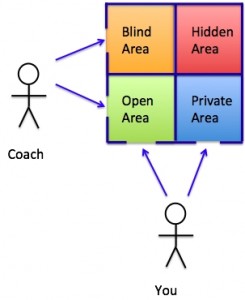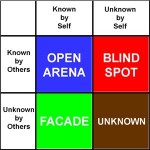
Johari Window
I was looking through some Coaching resources recently, and came across the Johari window as a possible coaching tool. Like many, I know of it, but couldn’t quite remember all the 4 quadrants, and re-appraising was a good exercise.
The Johari window is a useful tool to apply in coaching work . It can be helpful in explaining to a client how they can sometimes limit their self-knowledge and restrict their own understanding of their potential.
Perhaps the thing we most remember is that its named after the juxtaposition of the first names of its inventors, Joseph Luft and Harry Ingram. As a model it can help people understand elements of their behaviour, what they see of themselves, how it could be perceived by others and what isn’t being seen by anyone.
The 4 Quadrants
We all behave in a way that is visible to both ourselves and others.
This is our ‘Open Area’…the face we present to the world. This is constrained by our beliefs, values and social norms but allows us to function in the world.
We do, however, hide some of the things we believe (our personality and our desires) from other people and this is the ‘Private Area’.
This often protects both ourselves and others from perhaps harmful thoughts and comments. This is normally hidden by the facade that we present in our ‘Open Area’.
Good examples of this behaviour are how we limit what we say and perhaps tell little ‘white lies’ to protect the feelings of others, like saying we cant make a meeting because of a clashing committment, or the “creation” of another meeting.
People’s behaviour can often be interpreted in a manner different to what was intended. That area is called the ‘Blind Area’, visible to others, but blind to the client.
A coach, along with others will be able to see and comment on both the ‘Open Area’ (behaviour that the client exhibits) and this ‘Blind Area’.
This ‘Blind Area’ is the area that is open to interpretation or behaviour that the client cannot personally see or misinterprets.
This is typified for example by the Manager who thinks they are helping, but the staff member just sees it as over controlling, micromanaging and interfering. This is an area that a coach can be helpful in, as the feedback from a coach is provided without any agenda other than to benefit the client.
The final area is the ‘Hidden Area’. This is hidden from everyone, and is the region that a coach will help a client explore. This is where a client can find new resources, new values and potentially some very powerful insights into who they are and what it is that they want.
Self Reflection potential
Awareness of the framework can help individuals build effective communication with others, such as:
- Asking for Feedback – so others know the individual cares about what they think and that their opinion and views are taken seriously
- Self-Disclosure – taking opportunities to share things about oneself with others: being prepared to be vulnerable, so people can come to understand
- Self-Discovery – As people share things with others, this is a good time for them to find out more about themselves. As people self reflect more and share more about themselves, they grow as individuals
- The opportunity to work on things together as a Team. Some of the research was originally done in application to team theory, and it can be done as a powerful team exercise
Using the model
An awareness of the Johari window framework can allow a client to understand, that they sometimes interpret their behaviour in an entirely different way to the way that of others interpret that behaviour.
Secondly, a discussion about the ‘Hidden Area’ can often allow the client to accept that there are elements of everyone (including themselves) that are hidden from everyone, including themselves.
This allows the coach to them move the client into the frame of mind that allows them to start considering what possibilities are hidden away, just waiting to be discovered and exploited.
This approach can be a powerful way to help the client see that there is more untapped potential within them, accept that is the case and then agree to spend time looking for that untapped potential.
